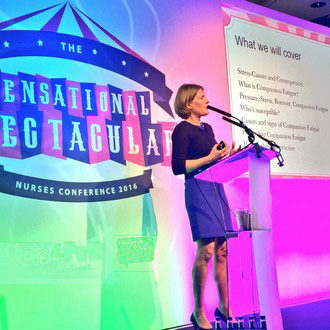Many years ago I was told that the secret to giving effective feedback was to ‘sandwich’ the areas where improvement may be required between the more positive stuff – an old-school coaching technique ably demonstrated by the lifestyle gurus at FOX’s ‘Family Guy’:
Stewie: Now, I’m going to do something I like to call the ‘Compliment Sandwich’, where I say something good, talk about where you need improvement, and then end with something good.
Brian the dog: Whatever you gotta do…
Stewie (flips notepad): Something good… something good… You look like SNOOPY and it makes me smile… but you have smelly dog farts.
It’s fair to say that a management tool has had its day when it’s being parodied on popular television. The ‘compliment sandwich’ falls down not only because it’s so overused, but also because the recipient knows what’s coming – braced for the negative comments so that they don’t hear the good bits.
Of course, feedback can be a tricky thing to get right. Many people put off giving it, hoping that colleagues and employees will identify the problem for themselves and do better next time. Which assumes that they realised something wasn’t right in the first place! Many of you reading this will have given feedback and had a defensive reaction because your words were taken as criticism rather than as advice on how to improve.
So how can we do better?
Providing feedback is an essential skill for all directors, managers and supervisors, in fact for all team members. Every member of your team requires feedback so that they can understand what they have done well (feeling proud of, and motivated by, their achievements) just as it’s vital to identify if there are skills and behaviours that can be further improved on.
Key elements of effective feedback include:
- Timeliness. Provide feedback as soon as possible, don’t gather everything up for the next time you meet, but also be aware that all parties need to be in the right place (both physically and mentally) and have the time to receive feedback positively.
- Suitable environment. Schedule a review meeting rather than throw a comment across the staff room. Choose a quiet room to ensure that there will be no interruptions. An open, honest conversation where expectations are proactively managed and people feel supported and comfortable is essential.
- Future focused. It’s important to acknowledge and comment on the current situation, the outcomes of behaviours and decisions made, but it’s also important not to get bogged down in the details and going over and over the problem. When negative behaviours/outcomes are being commented on, ask what needs to happen to prevent this happening again. Or if it’s positive feedback, asking, how can we get more of this?
- Openness and honesty. Make sure feedback is accurate – only report on things you have witnessed yourself or which come from a credible source. Providing inaccurate feedback is a sure way to disengage and demotivate your team members.
- Tailored communication. Structure your feedback according to the preferred style of the recipient – some people prefer to focus on results, others on details, some on how their performance affects the team and others on how it impacts on themselves.
- Positivity. It’s important not to get bogged down in what has gone wrong – focus on what learnings can be gained from events and identify what can be done differently in the future to improve performance.
On a practical level, managers and team leaders may also wish to note the following principles of good practice when giving feedback:
- Meet with each individual regularly so that you can review progress.
- Ask questions such as “What’s working well?” and “What’s not working well?” in order to encourage reflection on progress and identify areas for further improvement.
- Write down what you have agreed.
- Set the next date for your review.
- Monitor progress between review sessions.
- Touch base regularly.
- Concentrate on providing the motivating environment that everyone wants to be part of.
Traditionally, feedback has had a top-down approach, from bosses to employees. However, everyone benefits from honest, structured, well-meaning feedback, which is why many practices have adopted a 360 degree feedback process for appraisals. It can be hard reading at times, and being forced to take a look in the mirror can be daunting, but it’s always better to know where there are issues so that you can do something about it.
Of course, ultimately there is a fundamental problem with feedback – it focuses on the past. You can’t do anything to change the past, and so in this sense even the textbook, perfectly delivered feedback remains limited and static.
Ultimately, I recommend ‘feeding-forward’ instead – by focusing on the future we unlock infinite possibilities and our options become dynamic and expansive.








